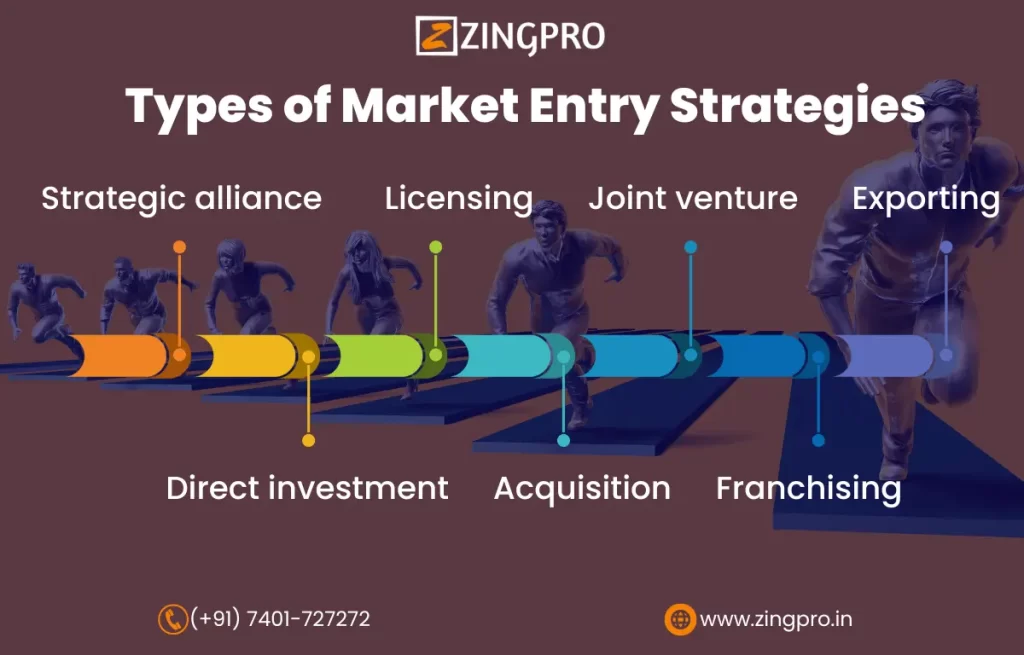Expanding into new markets can be a smart move for businesses looking to increase their customer base, grow their revenue, and diversify their operations. However, entering a new market can also be a challenging and risky process.
That’s why it’s important to choose the right market entry strategy for your business. In this blog, we’ll discuss the different types of market entry strategies and offer guidance on how to choose the best market entry strategy for India for your specific goals, resources, and market conditions.

Types of Market Entry Strategy for India
There are several different types of market entry strategy for India, including
- Exporting: This involves selling products or services to customers in a foreign market from your home country.
- Licensing: This involves allowing another company in a foreign market to use your intellectual property, such as patents or trademarks, in exchange for royalties or other payments.
- Franchising: This involves granting another company in a foreign market the right to use your brand name, business model, and operational systems in exchange for fees and royalties.
- Joint Ventures: This involves partnering with a local company in a foreign market to jointly establish and operate a new business.
- Acquisitions: This involves purchasing an existing company in a foreign market to gain access to its customers, products, and infrastructure.
- Greenfield Investments: This involves building a new business from scratch in a foreign market, such as establishing a new manufacturing plant or opening a new retail store.
Important for Market Entry Strategies
Market entry strategies are critical for businesses looking to expand their operations into new markets. Here are some reasons why market entry strategies are important:
- Entering a new market involves risk and significant financial investment.
- Market entry strategies can mitigate risks by identifying potential obstacles, challenges, and opportunities.
- Businesses can make informed decisions and reduce the risk of failure by understanding market dynamics.
- A well-planned market entry strategy can maximize ROI by minimizing costs and generating revenue quickly.
- Market entry strategies provide a clear roadmap for decision making.
- They facilitate decision making by providing a framework for evaluating different options.
- Careful consideration of the market entry strategy can give businesses a competitive advantage.
- Market entry strategies identify new opportunities and ways to achieve growth, both domestically and internationally.
Choosing the Right Market Entry Strategy
Choosing the right market entry strategy for India depends on several factors, including:
- Market Size: Is the market large enough to support your business and justify the investment required to enter it?
- Regulatory Environment: What are the legal and regulatory requirements for doing business in the foreign market? Are there any barriers to entry, such as tariffs, quotas, or licensing requirements?
- Cultural Differences: Are there significant cultural differences between your home country and the foreign market that could affect your ability to do business there?
- Competitive Landscape: Who are your competitors in the foreign market, and how do they operate? Is there room for your business to compete effectively?
Once you’ve considered these factors for the market entry strategy for India, you can evaluate the advantages and disadvantages of each market entry strategy and choose the one that best fits your needs.
For example, exporting may be a good option for businesses with limited resources, while joint ventures or acquisitions may be more appropriate for businesses with more extensive resources and experience in the target market.
Case Studies
Many businesses have successfully market entry strategy for India that used different market entry techniques to expand into new markets. For example, Coca-Cola used franchising to expand into over 200 countries, while Starbucks used joint ventures to enter China.
These companies faced challenges such as cultural differences, regulatory barriers, and competition, but they were able to overcome them by carefully planning and executing their market entry strategies.
Risks and Challenges
Entering a new market can be a risky and complex process. Businesses need to be aware of the risks and challenges of various market entry strategy for India associated with market entry, including legal and regulatory compliance, cultural barriers, operational complexities, and financial risks.
However, these risks can be mitigated through careful planning, market research, and risk management.
Implementation and Execution
Once you’ve chosen an India Market Entry strategy, you need to implement and execute it effectively. This may involve building a strong local team, establishing partnerships with local suppliers, and developing a marketing and sales strategy that takes into account the cultural and competitive landscape of the target market.
Comprehensive guide to market entry strategies for India
- Market Research: Conduct in-depth research on Indian market dynamics, consumer behavior, and competition.
- Legal Compliance: Understand and comply with India’s regulatory framework, exploring partnerships for smoother entry.
- Entry Modes: Consider joint ventures, alliances, or wholly owned subsidiaries based on business objectives and risk appetite.
- Cultural Adaptation: Customize products, services, and marketing to align with local cultural preferences and languages.
- Supply Chain Management: Optimize logistics and distribution channels for efficient and cost-effective operations across India’s diverse landscape.
- Technology Integration: Leverage digital platforms for marketing, e-commerce, and data analytics to reach a tech-savvy Indian consumer base.
- Government Relations: Establish positive relations with local authorities, navigating bureaucracy for a smoother market entry experience.
- Talent Acquisition: Invest in local talent, understanding the workforce dynamics and tapping into skilled professionals.
- Financial Planning: Develop a robust financial strategy considering currency fluctuations, taxes, and economic factors.
- Risk Management: Assess and mitigate risks associated with political, economic, and cultural factors to ensure a sustainable market presence.
Conclusion
Considering all these above factors that are discussed in the blog here can be a great gateway for India Market Entry that can influence market entry strategy selection, evaluating the advantages and disadvantages of different strategies, and mitigating risks and challenges through careful planning and execution, businesses can successfully enter.
Read also Outsourced Sales and marketing.


